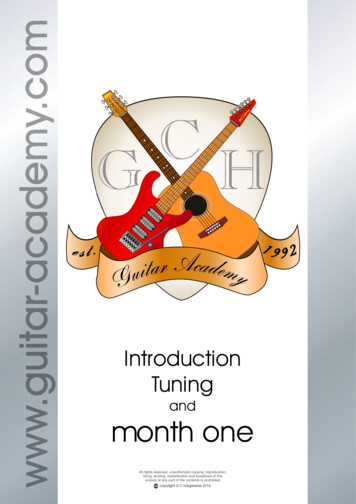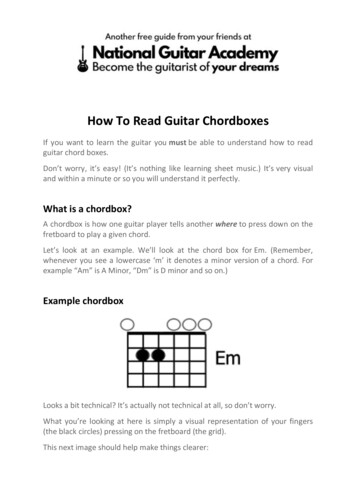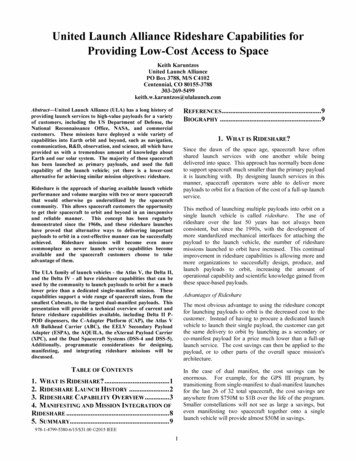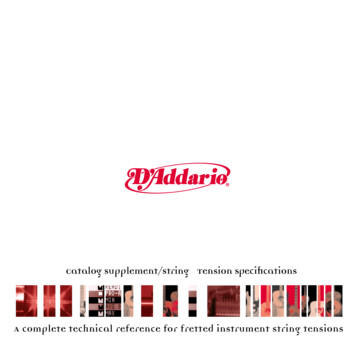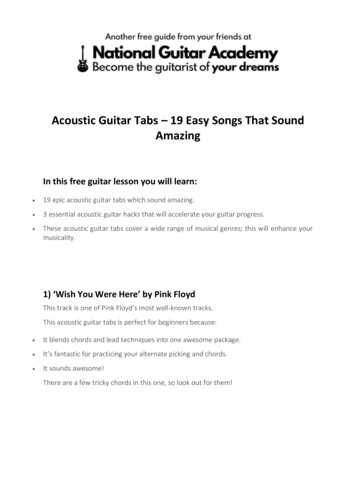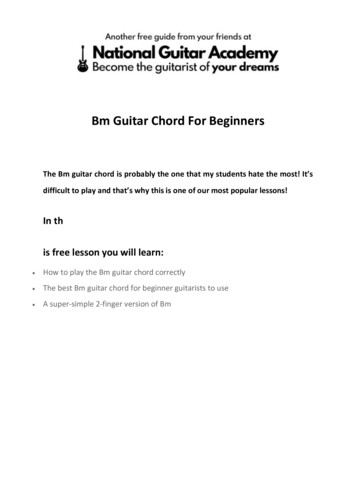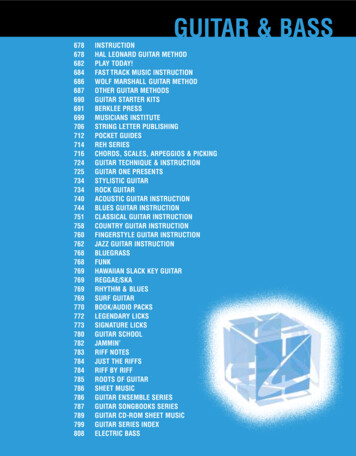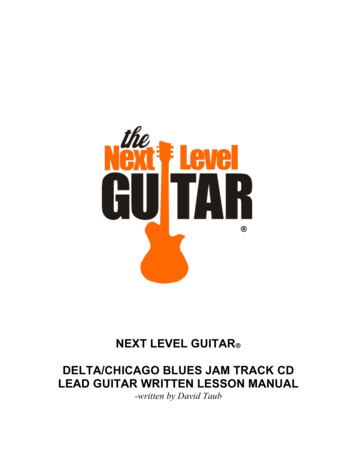
Transcription
NEXT LEVEL GUITAR DELTA/CHICAGO BLUES JAM TRACK CDLEAD GUITAR WRITTEN LESSON MANUAL-written by David Taub
INTRODUCTION:Hello good people! David Taub here and I want to take a second to thank you for purchasing this Next LevelGuitar instructional product. I think you will find that my teaching methods are of the best available on the markettoday. I have successfully taught thousands of students both privately and online all over the world and I amdedicated to getting your playing to the next level in the fastest and most efficient manner. This written lessonbooklet was designed to coincide with the Delta/Chicago Blues Jam Tracks Plus Audio CD.This Next Level Guitar Delta/Chicago Blues Jam Tracks CD comes complete with ten full on audio jam tracks.Each track includes a full band playing minus the lead guitar. The audio CD and this book of written lessons is anexcellent tool for the guitarist to develop and enhance their lead guitar playing, improvisation skills, music theoryknowledge, scale and mode learning, rhythm, and timing.Use these instructional materials to help open up guitar avenues and to examine different chords and rhythms,lead guitar techniques, learning the fretboard, music theory, scales, and the world of playing over chord changes.I designed these tracks and lessons to give you the most complete and limitless lead guitar picture possible.If you don’t keep a practice log you want to start one for sure. A three ring binder with filler paper works best. Printout this booklet of written lessons and keep it with all other music reference materials in the three ring binder.Keep these items handy so you can refer to them when studying and practicing.Add filler paper to your binder and keep accurate records in your practice log of the items you are working on,what needs work, chord changes, progressions, songs, original material, scales, etc. Date the entries and keeptrack of your progress as you move forward in your guitar journey. Just like setting goals in life you want to setmusical goals and then go out there and achieve them.Remember to follow my structured curriculum, keep on practicing the right things, and keep developing your ear.Don’t overwhelm yourself by trying to take on too many new things at once. Take these lessons and techniques instages and slow and steady wins the race. Some of the more advanced lead guitar avenues will take time todigest.One of the keys is consistency. Keep trying to put those guitars in your hands every day, even if it’s only for ten tofifteen minutes. You don’t necessarily need an hour block of time each day to learn guitar. Those little pockets oftime where you have a spare ten minutes or so that you can practice really add up.Make it easy for yourself to practice. Buy a guitar stand and keep your guitar out on the stand so it is accessible toyou at all times. Keep the guitar on the stand in a room you are in the most. This way you will be much more likelyto grab it and practice when you have that free ten minute pocket of time. Don’t keep your guitar packed up in itscase under your bed or packed away in the closet. Leave it out and make it accessible at all times.Like with anything new and different on the instrument dive into these materials with an open mind. Know that ifyou practice these techniques, work hard, keep honing your skills and refining your art that these methods willbring you results.Enjoy these materials and please let me know if you have any questions. I always welcome your insights andfeedback as I am constantly tweaking my instructional products to make them the best they can be. You canemail me at thenextlevelguitar@yahoo.comStay positive and remember that your guitar playing is an evolution.And please check out my full on video instructional website at www.nextlevelguitar.com now let’s get to it!I wish you the best in all your musical endeavors.Thanks again, enjoy the journey, and as always .ROCK ON!David Taubwww.nextlevelguitar.comCopyright Next Level Guitar Inc., 2011 - all rights reserved – unauthorized duplication or distribution of any part of this book is prohibited2
TABLE OF CONTENTS:Written LessonPageIntroduction . 2Table of contents & Delta/Chicago Blues Jam Track CD listings . 3Getting started . 4The choices when soloing . 5Key Signature and chord analyzing . 6Example progressions and soloing options – Major Key. 7-8Example progressions and soloing options – Minor Key. 9The tracks one by one - lead playing application over each jam track . 10-17Blues rhythms - The I-IV-V 12-bar blues . 18thChords – Dominant 7 chords . 19Notes on the fretboard . 20Lead Guitar – rhythm, the ride, note choice, & phrasing . 21Lead Guitar – the Big Four . 22The Minor Pentatonic scale . 23The Minor Pentatonic Expanded I Scale . 24The Minor Pentatonic Expanded II Scale . 25The Minor Pentatonic scale – five box scales . 26The Minor Pentatonic Blues scale . 27The Minor Pentatonic Blues Expanded II Scale . 28The Minor Pentatonic Blues scale all five box scales . 29Spicing up the Minor Pentatonic Blues scale . 30The Major Pentatonic scale . 31Major Pentatonic Sus4 scale . 32Major Pentatonic Sus4 scale links . 33Top ten key hints to get your playing to the next level . 34-35Chord construction . 36-37Building chords from the Major scale . 38Circle of fifths . 39Order of sharps & flats . 40Blank tablature staff paper (document your favorite licks & riffs) . 41-43NEXT LEVEL GUITAR DELTA/CHICAGO BLUES JAM TRACKS AUDIO CDTrack 1 – Shuffle in CTrack 2 – Slow Blues in ATrack 3 – Flat Tire in DTrack 4 – Two-beat Rolling in GTrack 5 – Box Groove in ATrack 6 – Slow Blues in ETrack 7 – Grinder in DTrack 8 – Mambo in ATrack 9 – Train Beat in GTrack 10 – Grinder in E118 BPM65 BPM116 BPM104 BPM119 BPM63 BPM99 BPM146 BPM136 BPM92 BPM4:10 min4:37 min4:14 min4:42 min4:10 min4:44 min4:32 min4:07 min4:16 min4:16 minCopyright Next Level Guitar Inc., 2011 - all rights reserved – unauthorized duplication or distribution of any part of this book is prohibited3
GETTING STARTEDKeep in mind that I want to give you the most complete guitar curriculum possible. This does not mean you haveto master every lead guitar avenue listed in each jam before moving on to the next jam. In fact you may notunderstand some avenues listed under each jam and that is okay.In these materials I teach many lead guitar avenues. Some will be more challenging than others and of coursetake more time to learn and apply. At first take the lead guitar paths that you are comfortable with or what I list outat the top of each jam first, playing what relates to all. Then continue to study these lessons and try moving downthe list of suggestions for each jam.Some of the soloing suggestions are more advanced and will take some time but remember there are no shortcuts here. Don’t rush things and don’t skim over topics. But over time you will find the principles and techniquesstart to sink in and eventually will become automatic.It’s important to take the extra time to learn about the “why” things work as I write out in the lessons throughoutthis book. Learning the “why things work” will give you the musical knowledge to blast these principles andtechniques across all your playing. It will give you the lead guitar confidence to be able to instantly know whatavenues are possible when soloing and improvising.That’s the trick, to use these lessons as “templates” or “vehicles” to learn the why things work, and then developthem into your guitar arsenal through practical application. Then you have the tools to blast these playingtechniques across all your playing at any given time, in any given jam, and in any given song.When first starting each jam I suggest listening to the chords and then playing the rhythm progression a few timesaround so you can feel the amount of measures on each chord and get a good feel for the changes. Listening isan art, so really try and dial in your ear.Don’t forget that even though this is a jam CD, to further develop your lead guitar skills you want to keeppracticing and working on your rhythm skills. Your rhythm and timing are critical elements to your overall abilitieson the guitar. Never forget that your lead playing will really only ever be as good as your rhythm playing.As I dive further and further into lead guitar techniques and concepts in this book, keep in mind that these verysystematic and methodical techniques will seem a bit daunting at first. However, these will soon become secondnature and automatic, they will become engrained in your playing style. You wont have to think about what to playso much as it will eventually become second nature. Then you will be letting your ear take you to all the rightnotes and chords and not having to think about techniques and application so much but rather focus on emotionand feel in your playing. The more you practice and apply these materials the faster you will be on “autopilot”.That said, throughout my teaching career I have found that first learning things utilizing this systematic approachwill get your playing to the next level the fastest. Remember we are building your guitar chops and you need tohave that solid foundation to build upon as you move along in your guitar journey.Because many blues progressions utilize I-IV-V chord changes you will often be utilizing Minor Pentatonic & Bluesand/or Major Pentatonic as potential lead playing avenues. Pentatonic scales are killer scales to play over bluesand over I-IV-V changes. They just ooze that minor bluesy vibe or sweet major vibe.Many big name players and rock bands have made careers using pentatonic scales. However, I urge you to trysome of the other suggestions that I list, don’t limit yourself. You will also want to eventually learn the modes ofthe major scale. Modes like Dorian, Aeolian, and Mixolydian can sound awesome over Blues progressions whenutilized properly.KEY POINT: Keep in mind that at this stage of your lead guitar playing journey there is just no substitutefor practicing the right things, learning scales, studying the sounds and relationships between chordsand scales, developing your ear, practicing and honing your skills using jam tracks, and continuallypushing yourself and refining your art.Remember that your guitar playing is an evolution. Stay positive, keep with it, swing for the fences, and also giveyourself plenty of fun time on the guitar to go along with all the hard work and studying.YOU CAN DO IT!4
THE CHOICES WHEN SOLOINGRemember when you are soloing or improvising, you have TWO CHOICES – you can:1. Play “what relates to all” – this means you solo with the same scale or same mode over all the chords. Nomatter what chord is being played in the progression you play the same scale or mode over each chord – you areplaying what works over ALL the chords and chord changes. You play the same scale or the same mode nomatter what chord is going by in the rhythm – you play what relates to all the chords.This is probably the most common choice among guitarists and definitely what most players do when first learningor developing their soloing skills and chops. So start with what relates to all. You want to get good at this firstbefore moving on to the next choice.OR YOU CAN:2. “Treat each chord like a separate event” - this choice is much more challenging but will give you a moresophisticated sound. By treating each chord as a separate event you solo with a different scale, mode, orarpeggio over each chord. So you can change your scale, mode, and/or arpeggio with each chord change. Youdon’t stay within the confines of the same scale as with what relates to all.This technique gives you a more sophisticated sound and is much more challenging to apply than playing whatrelates to all. You have to listen to what is going on underneath your soloing. You have to listen to what chordsare going by and you have to listen for the changes. You then have to time your playing and change your scalesand notes depending on what chord you are soloing over. More challenging but well worth the efforts as you canmake HUGE soloing statements employing this technique.You want to employ this technique when you have enough time on a given chord. Obviously if the chords areflying by fast you wont have enough time to treat each one as a separate event. So remember to listen to thechords and the amount of time on each chord to determine if this technique can be utilized. This technique takespractice getting used to but it will skyrocket your playing to the next level. Practice this technique at first with slowtempo progressions, like slows blues jam tracks, where there is lots of time on each chord before they change tothe next chord.KEY POINT: Keep in mind the above two choices are NOT mutually exclusive to one another. You can mixthem both. In fact I do that often when soloing. I treat each chord as a separate event for a while, then switch it upand play what relates to all or vice versa. It’s a great combination to do both and you get some great effects frommixing them both together. Many big name blues players like BB King and Eric Clapton employ these techniques.Sometimes you can even use both major and minor scale elements in certain jams as well as modal playing. Inthose type examples you can throw a bunch of different soloing applications into the soup. It all depends on thechords you are playing over. And again, this technique is very common in the blues.KEY POINT: When soloing and improvising in the blues you will often be soloing over I-IV-V progressions. Inthese scenarios you will have three chord changes that keep repeating throughout the progression – the I chord,the IV chord, and the V chord - just three chords to zone in on.After rhythmically playing through I-IV-V progressions for a while you will start to memorize the patterns, feel thechanges, and musically know when they are coming around. Knowing when the changes happen is critical forsoloing options over each chord and/or landing on the hip chord tones when the chord changes.As stated above, treating each chord separately, as an independent event will give your soloing more complexsounds and infinite possibilities. And with many blues progressions its mainly just three chords to hone into. Onthe following page we will study a few musical examples.5
KEY SIGNATURE & CHORD ANALYZINGOften in the Blues you will be soloing over progressions that are in either major key or minor key. Most often it willbe major key and often using dominant chords. But you want to have the tools to be able to solo over both majorand minor key.Knowing the key is important, and a good place to start. But to go deeper you have to analyze the chords thatmake up the progression to get the complete roadmap for soloing options.In the examples below we shall study a major key and minor key example of I-IV-V blues progressions and how tosystematically analyze the chords and determine various soloing options. Use these examples as templates whenexamining chords and progressions to determine soloing options. Always start with what are the chords and whatis the key.Like I mentioned previously to treat each chord as a separate event you have to have enough musical time oneach chord. If the chords are rolling by very fast then you will probably play more of what relates to all.After a while practicing these techniques, this procedure will become more automatic, but at first doing it in a verysystematic and methodical way will get you used to these principles.KEY POINT: Analyze the chords to determine what solo avenues to take – it’s the chords that give theroadmap to the various soloing avenues – the key signature is only part of the equation.It’s important to understand why these principles and techniques work so that you can solo over any progressionon your own. Armed with this knowledge and practicing in a musical context will give you the lead guitarconfidence to solo over any progression, song, or jam. So take the time to learn the whys – it’s a critical step.KEY POINT: Remember that as soon as you hear that very identifiable I-IV-V blues, swing, or shuffle, it iswide open as there will be many different soloing avenues to try.Key Points To Determine Soloing Avenues:1. Determine the key signature - most of the time you will be soloing in minor key or major key. Knowing the keyis the first step. Even when you are just noodleing around on the guitar, always know what key you are playing in.2. Analyze the chord progression – it’s the chords that will give you the complete roadmap to what you canutilize for soloing and improvisation. Analyzing the chords is critical to get the full lead guitar picture.Remember the points I list throughout these materials are guidelines to get you started off. They are notnecessarily rules forged in stone. Often in jams you have to use your discretion. You want to learn the principlesand techniques so you have a solid jump off point to get creative and then start bending the rules a bit.Keep in mind that you want to find a balance. After studying and learning the whys there has to come a pointwhen you take a break from learning scales and the theory behind them and just play music. Music is so muchmore than jus the logical application of theories and melodies. There is a human emotional element to music andthat is what you want to get across in your playing. So bone up yes, but get out there and PLAY!Be creative and keep in mind that there is just no substitute for practicing the right things, learning scales,studying the sounds and relationships between chords and scales, developing your ear, practicing and honingyour skills using jam tracks, and continually pushing yourself while honing you skills and refining your art.6
EXAMPLE PROGRESSIONS AND SOLOING OPTIONS – Major Key-If a progression is in major key you can almost always solo using Major Pentatonic over ALL the chords. Sothat should be a default setting. As soon as you hear major key, you know one option is to solo over all the chordswith Major Pentatonic, as it relates to all the chords.-MAJOR KEY I-IV-V blues, shuffles, and swings (like many of the jams on the CD):If a progression is a major key I–IV–V blues, swing, or shuffle there are MANY avenues to utilize when soloingand improvising. It’s wide open and these I-IV-V progressions are extremely common in the blues. And you cansolo over what relates to all and also try treating each chord as a separate event.-Try Minor Pentatonic & Blues scales over all the chords in the key of the progression for that bluesy minorsound. (Minor Pentatonic & Blues – 1,b3,4,b5,5,b7)-Try Major Pentatonic scales over all the chords in the key of the progression for that sweet major sound ala BBKing/Allman Brothers. This will be a totally different sound than Minor Pentatonic. (Major Pentatonic – 1,2,3,5,6)-Try mixing both Minor Pentatonic & Blues and Major Pentatonic. You will hear this a lot in the lead playing ofEric Clapton and BB King. The switching, combining, and mixing of Minor and Major Pentatonic is an awesomesound. (Minor & Major Pentatonic 1,2,b3,3,4,5,6,b7)nd-Try the Dorian Mode over all the chords in the key of the progression. Dorian is the 2 mode of the major scaleand is considered more of a minor mode but it’s intervals have elements of both minor, (b3, b7), and major (2nd,6th). So Dorian works great in any situation where you know both Minor Pentatonic and Major Pentatonic willwork. Give it at try over these I-IV-V blues progressions and you will be surprised how killer it can sound. (DorianMode – 1,2,b3,4,5,6,b7)ths-Try the Mixolydian Mode as it works great over dominant chords like 7 and 9th chords. Try to play this modeover each chord independently in the key of the chord. (Mixolydian Mode – 1,2,3,4,5,6,b7)1. EXAMPLE PROGRESSION I: E7-A7-B7 - Key of E Major I-IV-V progression - major key blues*What Relates to all the chords: There are many avenues here, totally wide open, so a lot will depend on yourplaying style and what type of mood or sound you want to create. Try some of these:-Try E Minor Pentatonic & Blues scales over all the chords for that bluesy minor sound (E,G,A,Bb,B,D)-Try E Major Pentatonic scales over all the chords for that sweet major sound (E,F#,G#,B,C#)Note: Remember that for any major key jam you can use Major Pentatonic over all the chords. Major Pentatonicrelates to all in this jam. E Major Pentatonic is the same as C# Minor Pentatonic. E Major and C# Minor arerelative major and minor. If you think more in terms of Minor Pentatonic or just know those shapes then play allyour C# Minor Pentatonic scales, but start on and emphasize the E notes and it will be E Major Pentatonic andhave that real major happy sweet sound.-Try mixing both E Minor Pentatonic and E Major Pentatonic over all the chords (E,F#,G,G#,A,B,C#,D)-Try the E Dorian over all the chords (E,F#,G,A,B,C#,D)Note: Because we know that both Major Pentatonic & Minor Pentatonic & Blues will work we then know that theDorian mode will also work. Dorian is considered more of a minor mode, (1,2,b3,4,5,6,b7), but works great overmajor key I-IV-V blues, swing, and shuffle progressions.7
ndthDorian has the minor elements in it (b3, b7) but also has some major elements, (2 , 6 ). So the Dorian mode willgive you that hybrid kind of minor/major sounds as it combines the elements of both minor and major. So try EDorian over all the chords.ndDorian is the 2 mode in any major key and E Dorian is the same as D major, (E Dorian D major). So play allyour D major scales but emphasize and start on the E notes – really resolve to and focus on those D notes.*Treat each chord like a separate event: Remember to always listen to the rhythm going on under your soloingand time your changes so you change your scale or landing notes as the chords change. Here are a few avenuesto try treating each chord as a separate event:-Try moving Minor Pentatonic & Blues over each chord:-Play E Minor Pentatonic & Blues over the E7 chord-Play A Minor Pentatonic & Blues over the A7 chord-Play B Minor Pentatonic & Blues over the B7 chord-Try moving Major Pentatonic over each chord-Play E Major Pentatonic over the E7 chord-Play A Major Pentatonic over the A7 chord-Play B Major Pentatonic over the B7 chord-Try mixing up the above Minor Pentatonic and Major Pentatonic over each chord – this is a very cooltechnique that many blues players often utilize.-Play E Major Pentatonic over the E7 chord. Then switch to E Minor Pentatonic over the A7 chord. Thentry E Major Pentatonic over the B7 chord. Listen to how well this technique outlines and implies the chordchanges. Mix this up a bit, maybe the next time around the progression try E Minor Pentatonic over theB7 chord.thth-Try Mixolydian mode over each chord: Mixolydian works great over 7 chords as there is that b7 in the 7thchords, (1,3,5,b7), as well as in the Mixolydian mode (1,2,3,4,5,6,b7). Mixolydian mode is the 5 mode of themajor scale.-Over the E7 chord try E Mixolydian ( A Major, start on and emphasize the E notes)-Over the A7 chord try A Mixolydian ( D Major, start on and emphasize the A notes)-Over the B7 chord try B Mixolydian ( E Major, start on and emphasize the B notes)8
EXAMPLE PROGRESSIONS AND SOLOING OPTIONS – Minor Key-In most instances if a song or jam is in minor key you can solo using Minor Pentatonic & Blues over all thechords. So that should be a default setting for minor key. As soon as you determine you are in minor key, or it’s amajor key bluesy I-IV-V, you know one option is to solo over all the chords with Minor Pentatonic & Blues scales.(An exception to this rule is if it’s a minor key progression with a major V chord – you have to be careful over thatmajor V chord - one option is to use Harmonic Minor over just that V chord).-Usually a minor mode will work over all the chords in a minor key jam. Usually it’s either Aeolian or Dorian. Todetermine which one you have to analyze the chords and look for certain things. For now just memorize thiscritical point for soloing in minor key over all the chords:KEY POINT: When playing over all the chords in a minor key progression you can always use the AEOLIANmode, UNLESS there is a IV major chord or II minor chord, then use the DORIAN mode. (Exception - If thereis a V major chord then use Harmonic Minor over just that V chord)Aeolian mode is the same thing as Natural Minor or Pure Minor.Aeolian mode Natural Minor Pure MinorWhen to use Minor Pentatonic & Blues Scales (4 great applications):1. Over all the chords in a minor key song, jam, or progression, (in most instances, few exceptions).2. Over all the chords in major key I-IV-V blues, shuffles, and swings.3. Over any minor type chord when treating each chord as a separate event.th4. Over all the chords in rock type jams, or jams using power or 5 chords, (as long as the jam is not realballad/major sounding, if so then use major pentatonic or possibly full major scales).2. EXAMPLE PROGRESSION II: Bm-Em-F#m Key of B minor I-IV-V progression minor key bluesThis example is in the key of B minor. We instantly know since we are in minor key, with no major V chord, wecan solo with Minor Pentatonic & Blues scales over all the chords.*What Relates to all the chords:-Try B Minor Pentatonic & Blues over all the chords. We instantly know since we are in minor key, with no majorV chord, we can solo with Minor Pentatonic & Blues scales over all the chords as those scales relates to all. Sowhether we are playing over the Bm chord, the Em chord, or the F#m chord one option is we can play B minorPentatonic & Blues scales all day long over all the chords.-Try B Aeolian over all the chords. Usually in minor key we can play a minor mode over all the chords. In minorkey a minor mode usually relates to all. We are in minor key and when analyzing the chords the IV chord is minor,(Em), this tells us we can also play B Aeolian mode, (B Natural Minor), over all the chords. So again whether weare playing over the Bm chord, the Em chord, or the F#m chord we can play B Aeolian scales over all the chords–it relates to all. B minor is the relative minor of D major. So play all your D major scales but start on andemphasize the B notes making it B Aeolian (B Aeolian D major).-Try mixing both B Aeolian and B Minor Pentatonic & Blues over all the chords for some killer sounds.*Treat each chord like a separate event:We can also try choice number two and treat each chord as a separate event. What this means is you play whatrelates to each chord separately and treat each chord independently. With this 12-bar progression you have a lotof time on each chord. This is perfect for treating each chord as a separate event-Over the Bm chord try B Minor Pentatonic & Blues, B Aeolian, B Dorian, or B minor arpeggios.(But then when the chords change to Em you then abandon all the B minor lead work and switch to scales,modes, or arpeggios that relate to the Em chord.)-Over the Em chord try E Minor Pentatonic & Blues, E Aeolian, E Dorian, or E Minor arpeggios.(Then when the chord changes again to F#m you abandon all the Em work and switch to what relates to the F#mchord.)-Over the F#m chord try F# Minor Pentatonic & Blues, F# Aeolian, F# Dorian, or F# minor arpeggios.9
THE TRACKS ONE BY ONE - LEAD PLAYING APPLICATION OVER EACH JAM TRACK ON THE CDKEY POINT: Use the below track listings as a template to follow when analyzing a song or jam todetermine soloing options. This will give you the lead guitar confidence to figure out soloing options overany song or any jam that you may encounter.Below is an outline of each track on the Delta/Chicago Blues Jam CD followed by a breakdown of the chords,progressions, key signature, and beats per minute, (BPM). Following each track is a list of suggestions on whatyou can try improvisation wise over the chords and progressions. I take you through the complete process in fullin the first jam below, shuffle in C –
Track 2 - Slow Blues in A 65 BPM 4:37 min Track 3 - Flat Tire in D 116 BPM 4:14 min Track 4 - Two-beat Rolling in G 104 BPM 4:42 min Track 5 - Box Groove in A 119 BPM 4:10 min Track 6 - Slow Blues in E 63 BPM 4:44 min Track 7 - Grinder in D 99 BPM 4:32 min
